|
Today's Reading: The Story of
the Stone (a.k.a. Dream of the Red Chamber) by
Cao Xuequin
Sacred
Sites
Lhasa:
Jokhang Temple from China
Guides
Lhasa:
Jokhang Temple from
tibettrip.com
|
|
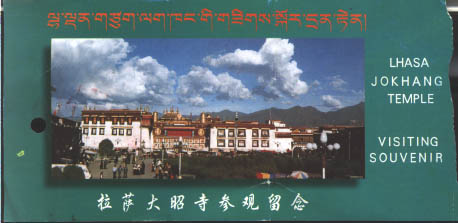
In contrast with the Potala the Jokhang Temple bustles
with life. People are actually praying and prostrating and
pilgrimming. The Jokhang Temple was built in the seventh
century by King Songtsen Gampo. The story according to
George (and the guidebook) is that Songtsen Gampo threw his
ring into the air, promising to build a temple wherever it
dropped. The ring fell into a lake and struck a rock where a
white stupa miraculously appeared. There is a white stupa
here that is alleged to be it, but I believe that a lot less
than I believed the cypress tree at Du Fu's cottage in
Chengdu. Anyway, the original structure built in the lake
(they filled part of the lake with rocks - kind of like the
Back Bay in Boston - it's not a floating temple) has been
added onto and enlarged eight times between the seventh
century and 1660.
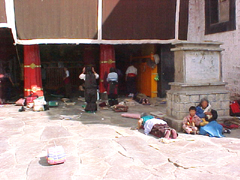 The
very first sight we saw was pilgrims doing prostrations. We
approached the temple from the Barkhor market through a long
gallery of prayer wheels. The prayer wheels have wooden
handles at the bottom to turn them by. I tried to make sure
I turned every single one. Some of the pilgrims were turning
those prayer wheels with one hand while they twirled
portable prayer wheels with the other. Some of those
portable prayer wheels were pretty big and the pilgrims
braced them against their bodies in kind of a sling like the
kind of thing flag bearers use to steady the flag in a
parade. The
very first sight we saw was pilgrims doing prostrations. We
approached the temple from the Barkhor market through a long
gallery of prayer wheels. The prayer wheels have wooden
handles at the bottom to turn them by. I tried to make sure
I turned every single one. Some of the pilgrims were turning
those prayer wheels with one hand while they twirled
portable prayer wheels with the other. Some of those
portable prayer wheels were pretty big and the pilgrims
braced them against their bodies in kind of a sling like the
kind of thing flag bearers use to steady the flag in a
parade.
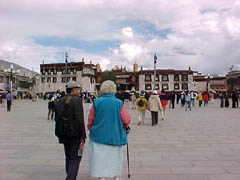 You
enter the Main Hall through a corridor with guardian statues
on either side - fierce on the left, benign on the right.
Like the Potala, the Jokhang Temple is chock full of
Buddhist art treasures. Murals depicting Princess Wen Cheng
arriving in Tibet, huge images of Padmasambhava and
Sakyamuni, a particularly beautiful Goddess (God?) of
Compassion, are all sort of preparation for the most holy
statue. The whole reason the temple was built was to house
the statue of Sakyamuni Buddha at 12. You
enter the Main Hall through a corridor with guardian statues
on either side - fierce on the left, benign on the right.
Like the Potala, the Jokhang Temple is chock full of
Buddhist art treasures. Murals depicting Princess Wen Cheng
arriving in Tibet, huge images of Padmasambhava and
Sakyamuni, a particularly beautiful Goddess (God?) of
Compassion, are all sort of preparation for the most holy
statue. The whole reason the temple was built was to house
the statue of Sakyamuni Buddha at 12.
Butter lamps flickered everywhere and there were whole
crews of monks, pilgrims, and people who evidently work at
the temple, dedicated to keeping the butter lamps going. A
combination of the altitude (this is only my second day here
still) and the smell of the butter lamps (rancid) made me
very nauseous. I kept fighting the urge to throw up. Carol
happened to have a barf bag from the airplane in her camera
bag, so gave it to me. I toured most of the temple with the
barf bag poised in front of my face. Finally I was truly
afraid I would throw up in the Holy of Holies so ran outside
into the courtyard.
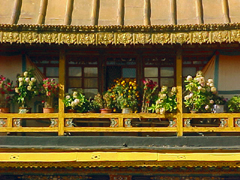 In
one corner of the courtyard people sat on the ground
cleaning butter lamps with a rag. They'd wipe out the butter
residue and polish the lamp then a little boy about 3 or 4
years old would run across the courtyard to where two old
women refilled the lamp with butter from a huge bag. The boy
was quite energetic and industrious running back and forth
over and over again. He showed no interest in begging, which
seems to be the main occupation of children who hang out at
the temple. "Goochi, goochi", which translates to "Please,
please" is their constant refrain. In
one corner of the courtyard people sat on the ground
cleaning butter lamps with a rag. They'd wipe out the butter
residue and polish the lamp then a little boy about 3 or 4
years old would run across the courtyard to where two old
women refilled the lamp with butter from a huge bag. The boy
was quite energetic and industrious running back and forth
over and over again. He showed no interest in begging, which
seems to be the main occupation of children who hang out at
the temple. "Goochi, goochi", which translates to "Please,
please" is their constant refrain.
There's a hierarchy of beggars, it seems, in terms of how
much merit you accumulate by giving to each type. As far as
I can tell, beggars come in three categories: monks,
musicians, and street people. Monks are worth the most
points in the karmic merit game. I'm not sure where
musicians stack up compared to the street people. Musicians
are not necessarily buskers the way we are used to them
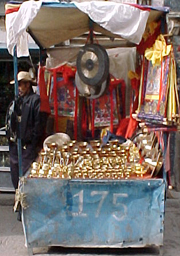 in
the west. A lot of them are just poor hungry people who
carry around musical instruments and beg, they don't
necessarily perform for you. Neither monks nor musicians
bothered us at the temple. Just kids and mothers. Some of
the kids were hard to get rid of. They followed us begging
constantly. They did not understand Chinese so repeating
"mei you" had no effect. We finally asked George how
to say mei you in Tibetan, which as I write this I
have totally forgotten. It didn't help anyway. in
the west. A lot of them are just poor hungry people who
carry around musical instruments and beg, they don't
necessarily perform for you. Neither monks nor musicians
bothered us at the temple. Just kids and mothers. Some of
the kids were hard to get rid of. They followed us begging
constantly. They did not understand Chinese so repeating
"mei you" had no effect. We finally asked George how
to say mei you in Tibetan, which as I write this I
have totally forgotten. It didn't help anyway.
Although I didn't barf in the courtyard, I continued to
feel very sick. I sat down on an old wooden wagon near where
the women were filling butter lamps. Beggars approached me
and I sent them away with a confused look and nonsensical
Chinese phrases. I figured maybe they'd think I was insane.
An old woman sat down next to me, so wrinkled I thought she
must be at least 100 years old. It took me a while to
realize that she was probably my age. She pulled a
small vial of snuff out of her robe and offered me some,
miming to me what it 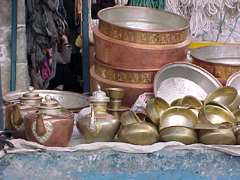 was
and how to take it. From her gestures it seemed she thought
it would help me with the altitude sickness. I couldn't
communicate to her that what I really had was butter lamp
sickness. I politely refused the snuff, thinking it would
send me totally over the edge and I would barf all over this
nice woman. We sat companionably for awhile then she
wandered off twirling her prayer wheel. was
and how to take it. From her gestures it seemed she thought
it would help me with the altitude sickness. I couldn't
communicate to her that what I really had was butter lamp
sickness. I politely refused the snuff, thinking it would
send me totally over the edge and I would barf all over this
nice woman. We sat companionably for awhile then she
wandered off twirling her prayer wheel.
I recovered enough to wander back into the temple for a
glimpse of the 12-year old Sakyamuni Buddha between the
shoulders of a crowd of Chinese tourists (egad, I am the
shortest person in the world - the average Chinese is taller
than me) before I was overcome with the rancid butter smoke
again. I made a mental note to tell my friend Joan-west, who
is studying to be a certified teacher of Tibetan Buddhism
(under the auspices of FPMT), that I cannot possibly
practice a religion that involves this many butter
lamps.
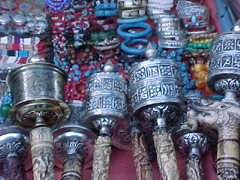 The
other interesting phenomenon I encountered while hanging out
in the courtyard waiting for Carol, Rosalie, and George was
the number of people who wanted to touch my belly for luck.
Apparently a large belly is very lucky in Tibet. Funny, in
Beijing the men thought I was sexy and here the men and
women and children think I'm lucky. I let people touch me
and I wished them tashi, but I did feel funny about
it. When the beggars wanted to touch me I wished I knew how
to ask them to pay me for the privilege. The
other interesting phenomenon I encountered while hanging out
in the courtyard waiting for Carol, Rosalie, and George was
the number of people who wanted to touch my belly for luck.
Apparently a large belly is very lucky in Tibet. Funny, in
Beijing the men thought I was sexy and here the men and
women and children think I'm lucky. I let people touch me
and I wished them tashi, but I did feel funny about
it. When the beggars wanted to touch me I wished I knew how
to ask them to pay me for the privilege.
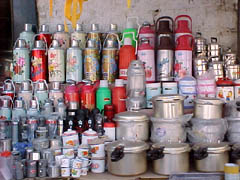 Certainly
my most vivid memories of the Jokhang will always be of the
bright sunny courtyard and the nauseating smell of butter
lamps, but I did manage to absorb some of the spiritual
essence of the place. A monk in the Lama Tsong Khapa (which
really sounds like John Denver whenever George says it)
chapel placed a white ceremonial scarf around my neck and
asked me where I was from. I did all the things I was told
would bring me good luck. So it wasn't like the entire
afternoon was only about being sick. Certainly
my most vivid memories of the Jokhang will always be of the
bright sunny courtyard and the nauseating smell of butter
lamps, but I did manage to absorb some of the spiritual
essence of the place. A monk in the Lama Tsong Khapa (which
really sounds like John Denver whenever George says it)
chapel placed a white ceremonial scarf around my neck and
asked me where I was from. I did all the things I was told
would bring me good luck. So it wasn't like the entire
afternoon was only about being sick.
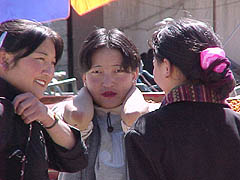 Our
visit to Jokhang and Barkhor took place on the second day in
Lhasa, in the afternoon after we'd visited the Potala. Add
the fatigue from that to the butter lamp sickness and the
altitude sickness and you get a picture of how wiped out I
was. The beauty and holiness of the temple got through to me
despite all that, but the visual splendor of the marketplace
really didn't, so on our last full day in Lhasa I went back
to photograph the Barkhor market again. The photos of dried
fruits, pretty girls, and thermoses are from that day. I can
see why people have to keep coming back. I could have spent
an entire day just photographing the market, not buying
anything or even visiting the temple. Our
visit to Jokhang and Barkhor took place on the second day in
Lhasa, in the afternoon after we'd visited the Potala. Add
the fatigue from that to the butter lamp sickness and the
altitude sickness and you get a picture of how wiped out I
was. The beauty and holiness of the temple got through to me
despite all that, but the visual splendor of the marketplace
really didn't, so on our last full day in Lhasa I went back
to photograph the Barkhor market again. The photos of dried
fruits, pretty girls, and thermoses are from that day. I can
see why people have to keep coming back. I could have spent
an entire day just photographing the market, not buying
anything or even visiting the temple.
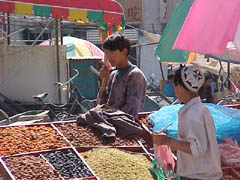 The
Jokhang is surrounded by the Barkhor market. Stalls sell
everything from dried fruits and nuts to blenders and other
appliances and everything in between. Essential pilgrim
supplies like giant bags of yak butter, ceremonial scarves,
and prayer wheels mix with stalls selling the ubiquitous
Chinese thermoses (the one essential of Chinese life is a
thermos of hot water), tin boxes, cookware, anything and
everything. Somehow it was both everything I'd imagined and
nothing I'd imagined. The
Jokhang is surrounded by the Barkhor market. Stalls sell
everything from dried fruits and nuts to blenders and other
appliances and everything in between. Essential pilgrim
supplies like giant bags of yak butter, ceremonial scarves,
and prayer wheels mix with stalls selling the ubiquitous
Chinese thermoses (the one essential of Chinese life is a
thermos of hot water), tin boxes, cookware, anything and
everything. Somehow it was both everything I'd imagined and
nothing I'd imagined.
|

 The
very first sight we saw was pilgrims doing prostrations. We
approached the temple from the Barkhor market through a long
gallery of prayer wheels. The prayer wheels have wooden
handles at the bottom to turn them by. I tried to make sure
I turned every single one. Some of the pilgrims were turning
those prayer wheels with one hand while they twirled
portable prayer wheels with the other. Some of those
portable prayer wheels were pretty big and the pilgrims
braced them against their bodies in kind of a sling like the
kind of thing flag bearers use to steady the flag in a
parade.
The
very first sight we saw was pilgrims doing prostrations. We
approached the temple from the Barkhor market through a long
gallery of prayer wheels. The prayer wheels have wooden
handles at the bottom to turn them by. I tried to make sure
I turned every single one. Some of the pilgrims were turning
those prayer wheels with one hand while they twirled
portable prayer wheels with the other. Some of those
portable prayer wheels were pretty big and the pilgrims
braced them against their bodies in kind of a sling like the
kind of thing flag bearers use to steady the flag in a
parade. You
enter the Main Hall through a corridor with guardian statues
on either side - fierce on the left, benign on the right.
Like the Potala, the Jokhang Temple is chock full of
Buddhist art treasures. Murals depicting Princess Wen Cheng
arriving in Tibet, huge images of Padmasambhava and
Sakyamuni, a particularly beautiful Goddess (God?) of
Compassion, are all sort of preparation for the most holy
statue. The whole reason the temple was built was to house
the statue of Sakyamuni Buddha at 12.
You
enter the Main Hall through a corridor with guardian statues
on either side - fierce on the left, benign on the right.
Like the Potala, the Jokhang Temple is chock full of
Buddhist art treasures. Murals depicting Princess Wen Cheng
arriving in Tibet, huge images of Padmasambhava and
Sakyamuni, a particularly beautiful Goddess (God?) of
Compassion, are all sort of preparation for the most holy
statue. The whole reason the temple was built was to house
the statue of Sakyamuni Buddha at 12. In
one corner of the courtyard people sat on the ground
cleaning butter lamps with a rag. They'd wipe out the butter
residue and polish the lamp then a little boy about 3 or 4
years old would run across the courtyard to where two old
women refilled the lamp with butter from a huge bag. The boy
was quite energetic and industrious running back and forth
over and over again. He showed no interest in begging, which
seems to be the main occupation of children who hang out at
the temple. "Goochi, goochi", which translates to "Please,
please" is their constant refrain.
In
one corner of the courtyard people sat on the ground
cleaning butter lamps with a rag. They'd wipe out the butter
residue and polish the lamp then a little boy about 3 or 4
years old would run across the courtyard to where two old
women refilled the lamp with butter from a huge bag. The boy
was quite energetic and industrious running back and forth
over and over again. He showed no interest in begging, which
seems to be the main occupation of children who hang out at
the temple. "Goochi, goochi", which translates to "Please,
please" is their constant refrain. in
the west. A lot of them are just poor hungry people who
carry around musical instruments and beg, they don't
necessarily perform for you. Neither monks nor musicians
bothered us at the temple. Just kids and mothers. Some of
the kids were hard to get rid of. They followed us begging
constantly. They did not understand Chinese so repeating
"mei you" had no effect. We finally asked George how
to say mei you in Tibetan, which as I write this I
have totally forgotten. It didn't help anyway.
in
the west. A lot of them are just poor hungry people who
carry around musical instruments and beg, they don't
necessarily perform for you. Neither monks nor musicians
bothered us at the temple. Just kids and mothers. Some of
the kids were hard to get rid of. They followed us begging
constantly. They did not understand Chinese so repeating
"mei you" had no effect. We finally asked George how
to say mei you in Tibetan, which as I write this I
have totally forgotten. It didn't help anyway. was
and how to take it. From her gestures it seemed she thought
it would help me with the altitude sickness. I couldn't
communicate to her that what I really had was butter lamp
sickness. I politely refused the snuff, thinking it would
send me totally over the edge and I would barf all over this
nice woman. We sat companionably for awhile then she
wandered off twirling her prayer wheel.
was
and how to take it. From her gestures it seemed she thought
it would help me with the altitude sickness. I couldn't
communicate to her that what I really had was butter lamp
sickness. I politely refused the snuff, thinking it would
send me totally over the edge and I would barf all over this
nice woman. We sat companionably for awhile then she
wandered off twirling her prayer wheel. The
other interesting phenomenon I encountered while hanging out
in the courtyard waiting for Carol, Rosalie, and George was
the number of people who wanted to touch my belly for luck.
Apparently a large belly is very lucky in Tibet. Funny, in
Beijing the men thought I was sexy and here the men and
women and children think I'm lucky. I let people touch me
and I wished them tashi, but I did feel funny about
it. When the beggars wanted to touch me I wished I knew how
to ask them to pay me for the privilege.
The
other interesting phenomenon I encountered while hanging out
in the courtyard waiting for Carol, Rosalie, and George was
the number of people who wanted to touch my belly for luck.
Apparently a large belly is very lucky in Tibet. Funny, in
Beijing the men thought I was sexy and here the men and
women and children think I'm lucky. I let people touch me
and I wished them tashi, but I did feel funny about
it. When the beggars wanted to touch me I wished I knew how
to ask them to pay me for the privilege. Certainly
my most vivid memories of the Jokhang will always be of the
bright sunny courtyard and the nauseating smell of butter
lamps, but I did manage to absorb some of the spiritual
essence of the place. A monk in the Lama Tsong Khapa (which
really sounds like John Denver whenever George says it)
chapel placed a white ceremonial scarf around my neck and
asked me where I was from. I did all the things I was told
would bring me good luck. So it wasn't like the entire
afternoon was only about being sick.
Certainly
my most vivid memories of the Jokhang will always be of the
bright sunny courtyard and the nauseating smell of butter
lamps, but I did manage to absorb some of the spiritual
essence of the place. A monk in the Lama Tsong Khapa (which
really sounds like John Denver whenever George says it)
chapel placed a white ceremonial scarf around my neck and
asked me where I was from. I did all the things I was told
would bring me good luck. So it wasn't like the entire
afternoon was only about being sick. Our
visit to Jokhang and Barkhor took place on the second day in
Lhasa, in the afternoon after we'd visited the Potala. Add
the fatigue from that to the butter lamp sickness and the
altitude sickness and you get a picture of how wiped out I
was. The beauty and holiness of the temple got through to me
despite all that, but the visual splendor of the marketplace
really didn't, so on our last full day in Lhasa I went back
to photograph the Barkhor market again. The photos of dried
fruits, pretty girls, and thermoses are from that day. I can
see why people have to keep coming back. I could have spent
an entire day just photographing the market, not buying
anything or even visiting the temple.
Our
visit to Jokhang and Barkhor took place on the second day in
Lhasa, in the afternoon after we'd visited the Potala. Add
the fatigue from that to the butter lamp sickness and the
altitude sickness and you get a picture of how wiped out I
was. The beauty and holiness of the temple got through to me
despite all that, but the visual splendor of the marketplace
really didn't, so on our last full day in Lhasa I went back
to photograph the Barkhor market again. The photos of dried
fruits, pretty girls, and thermoses are from that day. I can
see why people have to keep coming back. I could have spent
an entire day just photographing the market, not buying
anything or even visiting the temple. The
Jokhang is surrounded by the Barkhor market. Stalls sell
everything from dried fruits and nuts to blenders and other
appliances and everything in between. Essential pilgrim
supplies like giant bags of yak butter, ceremonial scarves,
and prayer wheels mix with stalls selling the ubiquitous
Chinese thermoses (the one essential of Chinese life is a
thermos of hot water), tin boxes, cookware, anything and
everything. Somehow it was both everything I'd imagined and
nothing I'd imagined.
The
Jokhang is surrounded by the Barkhor market. Stalls sell
everything from dried fruits and nuts to blenders and other
appliances and everything in between. Essential pilgrim
supplies like giant bags of yak butter, ceremonial scarves,
and prayer wheels mix with stalls selling the ubiquitous
Chinese thermoses (the one essential of Chinese life is a
thermos of hot water), tin boxes, cookware, anything and
everything. Somehow it was both everything I'd imagined and
nothing I'd imagined.